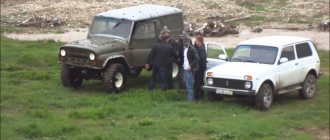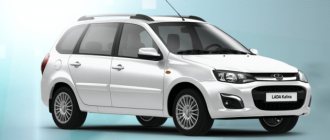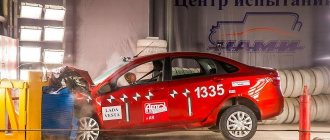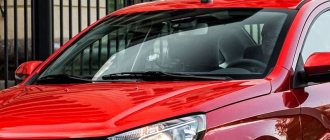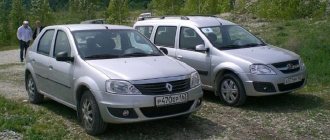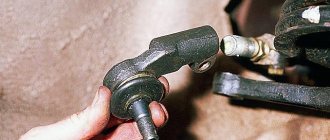Engine magazine continues to test the strength of automotive parts. This time we decided to check the steering tips for one of the most popular cars on the Russian market - Renault Logan . To do this, we purchased an original Renault and ten analogues of different price categories. Read on to find out what came of it.
So, the original Renault steering end with the original number 485202867R is used not only on the Logan and Sandero models, but also on the domestic analogue of the Romanian-French station wagon - Lada Largus. A good quality part is made in France and has a decent price: 1945 rubles.
Spare parts of the following brands were taken as analogues:
Test method
The test methodology is based on GOST R 52433-2005 “Automobile vehicles. Ball joints. Technical requirements and test methods”, which also applies to tie rods with ball joints (steering ends).
Tests related to the force of tearing and extrusion were carried out by applying a vertical load on a universal tensile-compression machine R20 in the laboratory of NPO Talis LLC; tests were also carried out there to test the anthers for frost resistance.
The minimum permissible values of the pullout force and the force of squeezing the pin out of the joint body are indicated in Appendix A to GOST, depending on the diameter of the ball pin. In this case, our steering tips have two pin sizes (22 and 25 mm), therefore, according to GOST, their minimum applied forces must differ. True, from a logical point of view, within the framework of applicability on the same car, this is not entirely true.
In the range of finger ball diameters from 21 to 24 mm, the minimum force for pulling out is 1500 kgf, for extrusion - 1900 kgf. For balls with a diameter of 24 to 27 mm - 2000 and 2500 kgf, respectively. The original ball joint did not come with a nut to attach it to the steering knuckle, so I had to use a heavy-duty Moog ball joint nut.
Having an original part in hand, we will consider its parameters as reference ones, since these are the characteristics that the manufacturer set for their car. In this case, we see that with a ball diameter of 22 mm, the pullout force is three times higher than the permissible values, which is the best result among all tested samples. But the extrusion force exactly corresponds to GOST, which is easily explained: the steering tip experiences minimal extrusion load in real driving conditions, in contrast to the breakout load when, for example, the car falls into a hole and the impact vector is directed from bottom to top.
The test results were mixed. Firstly, half of the manufacturers of non-original products make the ball diameter increased by 3 mm, which means that GOST standards for them will be increased. Secondly, for unknown reasons, some manufacturers, unlike the original Renault, showed the opposite endurance: with weak pullout rates, parts have a double pullout endurance, which is strange, since the steering tip almost does not experience such a load. One way or another, we decided to distribute the places according to the amount of points earned for tearing and extrusion, that is, according to the general parameter of the strength of the mechanism.
The leader in the measurements was the FAG steering end: the pull-out rate is two and a half times higher than GOST, the extrusion rate is twice as good. In second place is the Swag part, in third place is Lynx. Let us comment on the third place in more detail: the fact is that the Lynx tip showed a record breaking load of 5.3 tons, after which the thread of the part was cut off. However, taking into account the increased diameter of the ball, the load factor (2.65) of the spare part was still lower than that of the original, which withstood a threefold overload, while the thread remained intact.
The original Renault tip is formally in fourth place, but only because the extrusion parameter exactly corresponds to GOST - the automaker did not consider it necessary to make this characteristic more “hardy”.
With average performance, the Zekkert turned out to have rather weak metal - even with a double pullout load it cut off the thread.
Ashika and Fenox have average-to-consistent CTR scores, which is especially surprising for a respected CTR brand that regularly wins our tests. Well, the weakest are Torque, Moog and Flennor. The first one bent the metal under a not very heavy load, the second one did not pass the GOST standard for extrusion. The Flennor part, with a one-and-a-half-fold margin of strength for extrusion, also did not pass GOST standards for pull-out force, which means it is practically useless.
How to choose a new part
When selecting a steering tip, you do not need to take into account many characteristics, as would be the case when selecting, say, starter parts. You can search as follows:
- By VIN code . In this case, the car enthusiast is guaranteed to find a suitable original spare part. Searching by vehicle code can be complicated by the fact that existing electronic systems automatically “pull up” the analogues closest to the original. How to understand them?
- According to the spare part code . This is just the option when you have a lot of codes and you can’t decide which is best to choose. Here you need to take into account who manufactured the spare part. We'll talk about manufacturers later. You just have to remember that today, thanks to access to the network and the presence of many good electronic stores, you can check every code and get maximum information about each spare part;
- According to the car . Another option involves the use of electronic catalogs. Although a car enthusiast can always contact an official store, it is easier to search for a spare part online. You must indicate the make, model of the car, body and year of manufacture. The system will automatically select the original and the closest analogues.
During the search, a car enthusiast will note that it is very easy to select a tip using any of the three methods. The problem is different - original or non-original? Let's figure it out.
Freezing anthers
According to established custom, we are expanding the test methodology and testing pre-removed rubber boots of steering tips for frost resistance. The parts are kept at a temperature of –40 °C for 24 hours, followed by testing for loss of elasticity, since the tip is guaranteed to fail if sand, dirt and salt, which are sprinkled on winter roads, get inside the joint.
By the way, it is worth mentioning separately that only the original Renault part and the CTR boot have metal rings inside to ensure a tighter fit to the ball pin, for which both can be given a point. For FAG, the protective boot is made of transparent polyurethane. Most manufacturers have CR markings on their anthers, which indicates that these covers are made of chloroprene rubber.
To our surprise and to the honor of the manufacturers, all tested samples successfully withstood the temperature of –40 °C, so in most regions of our country the anthers will withstand weather conditions.
However, we decided to subject the parts to extreme stress and lowered the temperature to -50 ° C. Only four parts were able to withstand this figure - Renault, FAG, Lynx and Zekkert, to which we assign an additional point. The CTR held on until the last, opening up like a rose, but without losing a single piece of rubber. The remaining anthers scattered.
How to check the condition of the tie rod end
To carry out an inspection, you should drive your car onto an overpass or inspection hole. It is quite possible to get by using a jack if there is no access to the inspection hole. The sequence of actions is as follows:
- Use a rag to clean the parts from dirt;
- Inspect the mounting points;
- Carefully inspect the steering tip boot. A boot covered with cracks definitely needs to be replaced;
- Have an assistant turn the steering wheel and observe the operation of the tip. If it has moved along the length of the finger axis by a distance of more than 1.5 millimeters, then we can talk about the presence of play.
If the steering tip has play, it must be replaced as soon as possible. Anthers are consumables, so if there is the slightest damage, they can be safely replaced with new ones.
We also note that primary diagnostics can be carried out not only with the car raised, but also with the wheels removed or hung. This is true for checking ball joints, stabilizer bars and bearings. However, to get a complete picture, it is still worth carefully examining the underbody of the car and the steering elements in particular.
Chemical analysis of metal
The final part of the tests in accordance with GOST requirements is chemical analysis and determination of the steel grade for the ball pin. To do this, we transferred the previously torn fingers from the hinges to the accredited laboratory of the Volna Plant NPO, which has at its disposal a DFS-500 spectrometer to recognize the amount of each alloying or deteriorating element in the steel composition.
The obtained result showed that in almost all the studied ball joints of steering tips, structural alloy steels within 40X with a chromium content of about 1% and manganese within 0.7% are used. The Lynx and Zekkert tips (the only ones whose threads were cut off) did not show any deviations in the metal, as did the bent Torque. For the CTR ball end, the ball pin is made of 35ХМ steel - in addition to chromium and manganese, molybdenum is added to the alloy as an alloying additive, which increases strength and wear resistance.
Which steering tip boot should you prefer?
A separate question: how to choose a tip boot? If you clarify the compatibility of the boot with your car, which, again, is easiest using the capabilities of the World Wide Web, then all that remains is to choose the material of the product and give preference to a specific manufacturer. You should know the following about materials:
- Rubber is a cheap and wear-resistant material. Today, almost all manufacturers have learned to work with it. You can take an inexpensive domestic boot and travel about 40 thousand kilometers with it (sometimes it goes even more). Rubber tends to harden in the cold and does not perform well in northern latitudes - it begins to crack, which negatively affects the operation of the tie rod end;
- Polyurethane is tougher and more durable than rubber. Not all cars are supplied with polyurethane bushings and boots. If you have a relatively new foreign car, then several European companies are definitely involved in the production of polyurethane boot tips and CV joints.
When choosing anthers, you should refer to the electronic catalog or use the search by codes or VIN code of the car. It is necessary to take into account the internal and external diameters (denoted in catalogs as d and D), length (L). If the new boot completely replicates the old one, its code should be saved. Next, you will need to select analogues and decide on the brand. Give preference to anthers from:
The steering tip boot can be found in the catalogs of almost all steering system component manufacturers, but there is one catch: the boot is rarely sold separately - only in a set with the tip. The hardest thing to find separately are Lemforder anthers, and the easiest ones are Febi and Mobis.
What's the result?
In terms of the total points earned, first place is unconditionally occupied by the FAG steering end from the German giant Schaeffler: not a single weak point in all the measurements taken.
In second position remains the Swag part from another German concern Bilstein Group - however, with the allowance for the fact that the boot may not withstand a very harsh winter.
On the third step with an equal number of points are the original Renault and the tip from Lynx. The native French part has a record for breakout parameters, a competent protective design and resistance to any frost, although it has the highest price. The Lynx part also has excellent pull-out strength and frost resistance.
In general, the total indicators of two more brands - Zekkert and CTR - are also quite good. The latter received an extra point for the protective design of the boot. Flennor and Moog parts did not meet GOST standards and could not withstand severe frosts. The rest performed to varying degrees below average.
The magazine "Engine" expresses gratitude to the laboratory of NPO "Talis" for their assistance in preparing and conducting the test.
Brand tour
As practice shows, original steering tips can be head and shoulders above their analogues, or they may not differ significantly from them. The fact is that European automakers order steering parts from manufacturers who produce products under their own name. For example, if you have a Volvo , Audi , Volkswagen or BMW , then it has Lemforder steering ends. In fact, when you buy a branded spare part in a package with the name of this manufacturer, you are buying the same original, but at a much more affordable price. You should pay attention to the products of the following companies first of all:
- Lemforder (Germany) – as already mentioned, original quality at a low price;
- TRW (Germany) - the company is known for selling fairly high-quality spare parts at very affordable prices. They are inferior in quality to the originals;
- MOOG (USA) is a renowned manufacturer of suspension parts. Spare parts from the American manufacturer cost a lot, but they are head and shoulders above many other analogues. Beware of fakes!
- Mapco (Germany) is a manufacturer that has been undeservedly ignored by almost all car enthusiasts. In terms of price-quality ratio, its spare parts are among the best on the market. The steering parts perform well on Russian and Ukrainian roads;
- Nakamoto (Taiwan) - offers excellent tips for Asian-made cars. Today, the Thai company's products are exported to 50 countries, which is a good indicator;
- Febi (Germany) is a manufacturer that collects not the most flattering reviews. However, in general, the average quality of spare parts and consumables is compensated by incredibly low prices. If you are looking for a budget tip and boot, then you should pay attention to the products under the name Febi;
- CTR (South Korea) is another manufacturer offering inexpensive steering gear parts. At the same time, the quality of all parts is very high. The situation is overshadowed by the huge number of fakes that have flooded the secondary market for auto parts.
Spare parts for Audi 50
Spare parts for audi a6
Good tips are also offered by Delphi (USA), Wulf Gaertner Autoparts AG (Germany), GTR (Taiwan), SWAG (Germany). The latter company offers the most budget analogues, the quality of which clearly does not break records.
Rating of the TOP 5 best manufacturers of ball joints for cars: how to replace, reviews
The ball joint is one of the most important parts of the car, so a sudden failure can cause an accident. This is the very detail on which it is not recommended to save. Experts recommend regularly changing the device to prevent vehicle breakdowns with serious consequences.
How not to make a mistake in choosing and buy a really good device? To make your search easier, we have compiled a rating of the TOP 5 best manufacturers of ball joints for cars: how to replace them, reviews are discussed below.
Is it possible to replace the tip yourself?
The procedure for replacing individual steering elements is not complicated and takes an average of 20 minutes. The same work can be entrusted to a master, who will probably do it even faster. However, if you decide to replace the tip yourself , then follow the following algorithm:
- Raise the car or leave it above the inspection hole;
- Unscrew the bolts connecting the wheels to the car suspension;
- Loosen the pin (pin) nut, leaving it on the thread;
- Put on a puller that will make it easier to squeeze out your finger;
- Get rid of the nut and take out the pin;
- Remove the locknut located on the steering rod of the car;
- Remove the tip;
- It remains to mark the location of the existing tie rod and count the number of revolutions that the body of the old tip makes.
Now you need to install a new steering tip. After installing a new spare part, driving your car will become more reliable, easier and much safer. After replacement, it is strongly recommended to undergo a wheel alignment at the nearest station - experts unanimously agreed that this procedure is mandatory after replacement.
Restoration of steering gear elements is not recommended. The fact is that it will be difficult for a car enthusiast to monitor compliance with factory parameters and soberly assess the cost of restoration. It’s easier to buy new parts and install them yourself. It is also easy to replace the anthers yourself without the help of a specialist.


